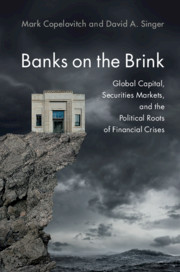Book contents
- Banks on the Brink
- Political Economy of Institutions and Decisions
- Banks on the Brink
- Copyright page
- Dedication
- Contents
- Figures
- Tables
- Preface
- Acknowledgments
- 1 The Politics and Economics of Financial Instability
- 2 Banking Crises, Capital Flows, and Financial Market Structure
- 3 Capital Inflows, Market Structure, and Banking Crises
- 4 O Canada? Unraveling the Mystery of Canadian Bank Stability
- 5 Finanzplatz Deutschland
- 6 Policy Responses
- References
- Index
- Political Economy of Institutions and Decisions
5 - Finanzplatz Deutschland
German Bank Stability and Its Decline
Published online by Cambridge University Press: 10 February 2020
- Banks on the Brink
- Political Economy of Institutions and Decisions
- Banks on the Brink
- Copyright page
- Dedication
- Contents
- Figures
- Tables
- Preface
- Acknowledgments
- 1 The Politics and Economics of Financial Instability
- 2 Banking Crises, Capital Flows, and Financial Market Structure
- 3 Capital Inflows, Market Structure, and Banking Crises
- 4 O Canada? Unraveling the Mystery of Canadian Bank Stability
- 5 Finanzplatz Deutschland
- 6 Policy Responses
- References
- Index
- Political Economy of Institutions and Decisions
Summary
Banking stability has long been a hallmark of Germany’s economy. This image has been historically embodied by the solid stone façades of Germany’s largest banks (now replaced by the glass-and-steel Frankfurt skyline), as well as the stereotypical image of the conservative German banker, clad in his well-tailored dark suit and gazing sternly at the camera through wire-rimmed glasses. Ever since the rise to international prominence of German banking empires, such as the Fuggers, Welsers, and Rothschilds, in the sixteenth to eighteenth centuries, German bankers have had a reputation for prudence, competence, and stability. Until recently, this reputation was largely deserved: with the exception of the interwar era/Great Depression and the notable failure in 1974 of Herstatt Bank – a small private bank that highlighted problems of settlement risk in global finance – the German banking system has been remarkably resilient throughout modern history.
- Type
- Chapter
- Information
- Banks on the BrinkGlobal Capital, Securities Markets, and the Political Roots of Financial Crises, pp. 124 - 180Publisher: Cambridge University PressPrint publication year: 2020

